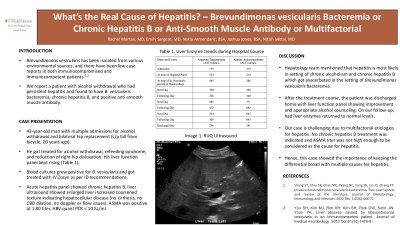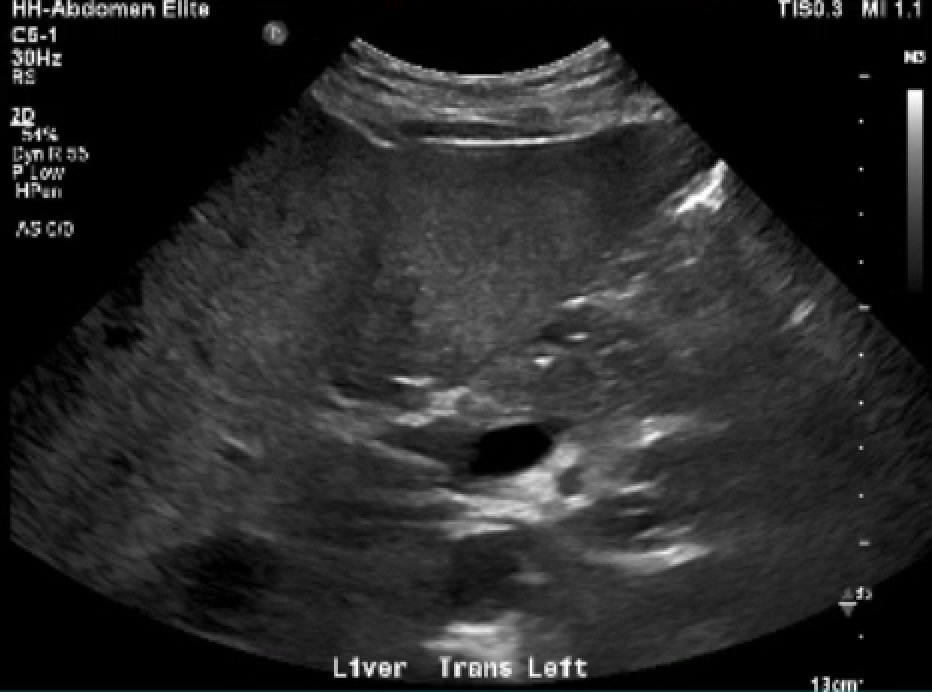Sunday Poster Session
Category: Liver
P1354 - What’s the Real Cause of Hepatitis? - Brevundimonas vesicularis Bacteremia or Chronic Hepatitis B or Anti-Smooth Muscle Antibody or Multifactorial
Sunday, October 27, 2024
3:30 PM - 7:00 PM ET
Location: Exhibit Hall E

Has Audio

Rachel Mortan, MD
University of Texas Health, McGovern Medical School
Houston, TX
Presenting Author(s)
Rachel Mortan, MD, Emily Sargent, MD, Joshua Jones, BS, Nakia Armendariz, BS, Nitish Mittal, MD
University of Texas Health, McGovern Medical School, Houston, TX
Introduction: Brevundimonas vesicularis (B. vesicluaris) has been isolated from various environmental sources, but there have been only few case reports in both immunocompromised and immunocompetent patients. Herein, we present a patient with alcohol withdrawal who had constant hepatitis and found to have chronic hepatitis B, B. Vesicularis bacteremia, and positive anti-smooth muscle antibody.
Case Description/Methods: A 43-year-old man with multiple admissions for alcohol withdrawal, and bilateral hip replacements, was brought to the hospital after a ground level fall that resulted in dislocation of his right prosthetic hip. He was admitted for treatment of alcohol withdrawal, refeeding syndrome, and reduction of his right hip dislocation. He got treated for alcohol withdrawal but the liver enzymes kept rising even after treatment (Table 1). His electrolytes, lipid panel, and A1c were within normal limits, but noted to have macrocytic anemia and thrombocytopenia which eventialyl resolved. His blood cultures grew positive for B. vesicularis, and got zosyn for a 7 day course. An acute hepatitis panel showed chronic hepatitis B with HBsAg positive, anti-HBC Ab positive, anti-HBs negative (< 5), HBeAb positive, HBeAg negative. Hepatology team recommended liver ultrasound that demonstrated an enlarged liver with increased and coarsened echotexture suggestive of fatty infiltration and hepatocellular disease, there was no sonographic evidence of frank cirrhosis, no CBD dilation, no doppler or flow abnormalities (Image 1). ANA, anti-mitochondrial antibody, AFP, ceruloplasmin, and alpha-1 antitrypsin were unremarkable. His anti-smooth muscle antibody returned positive with an intermediate 1:80 titer. His HBV quant PCR was < 10 IU/mL. Hepatology team mentioned that hepatitis is most likely in the setting of chronic alcoholism and chronic hepatitis B, which got exacerbated in the setting of B. vesicularis bacteremia. After the treatment course, the patient was discharged home with appropriate alcohol counseling and follow-ups.
Discussion: Our case is challenging due to multifactorial etiologies for hepatitis. Interestingly, even after treatment for the rare B. vesicularis, the liver enzymes remain elevated. Hepatology team decided to not pursue chronic hepatitis B treatment inpatient, and anti-smooth muscle antibody titer was not high enough to be considered for the cause of this hepatitis. Hence, this case showed the importance of keeping the differential broad with multiple causes for the liver enzyme elevation.

Note: The table for this abstract can be viewed in the ePoster Gallery section of the ACG 2024 ePoster Site or in The American Journal of Gastroenterology's abstract supplement issue, both of which will be available starting October 27, 2024.
Disclosures:
Rachel Mortan, MD, Emily Sargent, MD, Joshua Jones, BS, Nakia Armendariz, BS, Nitish Mittal, MD. P1354 - What’s the Real Cause of Hepatitis? - Brevundimonas vesicularis Bacteremia or Chronic Hepatitis B or Anti-Smooth Muscle Antibody or Multifactorial, ACG 2024 Annual Scientific Meeting Abstracts. Philadelphia, PA: American College of Gastroenterology.
University of Texas Health, McGovern Medical School, Houston, TX
Introduction: Brevundimonas vesicularis (B. vesicluaris) has been isolated from various environmental sources, but there have been only few case reports in both immunocompromised and immunocompetent patients. Herein, we present a patient with alcohol withdrawal who had constant hepatitis and found to have chronic hepatitis B, B. Vesicularis bacteremia, and positive anti-smooth muscle antibody.
Case Description/Methods: A 43-year-old man with multiple admissions for alcohol withdrawal, and bilateral hip replacements, was brought to the hospital after a ground level fall that resulted in dislocation of his right prosthetic hip. He was admitted for treatment of alcohol withdrawal, refeeding syndrome, and reduction of his right hip dislocation. He got treated for alcohol withdrawal but the liver enzymes kept rising even after treatment (Table 1). His electrolytes, lipid panel, and A1c were within normal limits, but noted to have macrocytic anemia and thrombocytopenia which eventialyl resolved. His blood cultures grew positive for B. vesicularis, and got zosyn for a 7 day course. An acute hepatitis panel showed chronic hepatitis B with HBsAg positive, anti-HBC Ab positive, anti-HBs negative (< 5), HBeAb positive, HBeAg negative. Hepatology team recommended liver ultrasound that demonstrated an enlarged liver with increased and coarsened echotexture suggestive of fatty infiltration and hepatocellular disease, there was no sonographic evidence of frank cirrhosis, no CBD dilation, no doppler or flow abnormalities (Image 1). ANA, anti-mitochondrial antibody, AFP, ceruloplasmin, and alpha-1 antitrypsin were unremarkable. His anti-smooth muscle antibody returned positive with an intermediate 1:80 titer. His HBV quant PCR was < 10 IU/mL. Hepatology team mentioned that hepatitis is most likely in the setting of chronic alcoholism and chronic hepatitis B, which got exacerbated in the setting of B. vesicularis bacteremia. After the treatment course, the patient was discharged home with appropriate alcohol counseling and follow-ups.
Discussion: Our case is challenging due to multifactorial etiologies for hepatitis. Interestingly, even after treatment for the rare B. vesicularis, the liver enzymes remain elevated. Hepatology team decided to not pursue chronic hepatitis B treatment inpatient, and anti-smooth muscle antibody titer was not high enough to be considered for the cause of this hepatitis. Hence, this case showed the importance of keeping the differential broad with multiple causes for the liver enzyme elevation.

Figure: Liver U/S showing increased and coarsened echotexture suggestive of fatty infiltration and hepatocellular disease.
Note: The table for this abstract can be viewed in the ePoster Gallery section of the ACG 2024 ePoster Site or in The American Journal of Gastroenterology's abstract supplement issue, both of which will be available starting October 27, 2024.
Disclosures:
Rachel Mortan indicated no relevant financial relationships.
Emily Sargent indicated no relevant financial relationships.
Joshua Jones indicated no relevant financial relationships.
Nakia Armendariz indicated no relevant financial relationships.
Nitish Mittal indicated no relevant financial relationships.
Rachel Mortan, MD, Emily Sargent, MD, Joshua Jones, BS, Nakia Armendariz, BS, Nitish Mittal, MD. P1354 - What’s the Real Cause of Hepatitis? - Brevundimonas vesicularis Bacteremia or Chronic Hepatitis B or Anti-Smooth Muscle Antibody or Multifactorial, ACG 2024 Annual Scientific Meeting Abstracts. Philadelphia, PA: American College of Gastroenterology.
